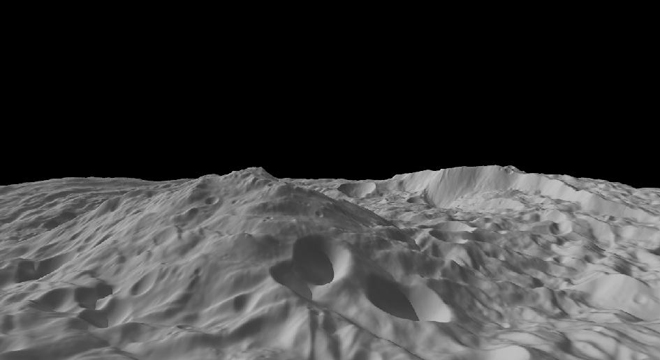Mount Everest is just another hill of beans compared to a mountain on the south pole of the asteroid Vesta, now visible in glorious 3D thanks to NASA’s DAWN spacecraft, which is currently in orbit around the asteroid.
Vesta’s south polar peak (shown just off to the left of the center of the image above) rises up 13 miles over its surrounding terrain, compared to Everest’s height of about five and a half-miles. It’s also just underneath the height of the largest currently known mountain in the solar system, the volcano Olympus Mons on Mars, which towers above them all at 16 miles.
The new computer-generated image of the mountain, released by NASA on Monday, was generated from a shape model of the planet’s rocky and pockmarked surface, itself captured in images taken by the DAWN spacecraft’s twin framing cameras.
NASA explains on its website that the image it created has been flattened to show the terrain of the asteroid more clearly, noting that an observer on the surface wouldn’t be able to get the same comprehensive view due to the curve of the horizon.
On Wednesday, scientists working on the DAWN mission, which launched in 2007, presented their initial findings about Vesta’s south hemisphere at the annual conference of the Geological Society of America in Minneapolis, Minn.
According to NASA’s Jet Propulsion Laboratory in Pasadena, California, which pilots the DAWN spacecraft, one of the major findings relates to the age and composition of the asteroid’s southern hemisphere surface structure:
“The surface appears to be much rougher than most asteroids in the main asteroid belt. In addition, preliminary dates from a method that uses the number of craters indicate that areas in the southern hemisphere are as young as 1 billion to 2 billion years old, much younger than areas in the north.
Vesta, which was first discovered in 1807 by amateur German astronomer Heinrich Wilhelm Olbers, is the brightest visible asteroid from Earth, despite being 136 million miles away. It got its first close-up from the Hubble Space Telescope in 1994, but only became visible in-detail to scientists thanks to the arrival of the DAWN orbiter in July.
The DAWN spacecraft is due to continue its survey of Vesta, the solar system’s second or third largest asteroid (scientists still aren’t sure whether it has a larger volume than another astroid in the belt, Pallas) until mid-2012. After that, it will head for the largest body in the asteroid belt, the dwarf planet Ceres, which it is expected to reach in 2015.









